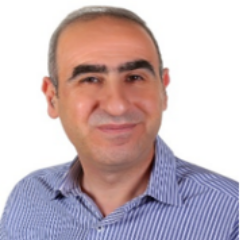
Rabah AlShboul
Work place: Computer Science Department, Prince Hussein Bin Abdullah College for Information Technology, Al Albayt University, Mafraq, 25113, Jordan
E-mail: rabahshboul@aabu.edu.jo
Website:
Research Interests: Sensor, Network Security, Cloud Computing, Wireless Sensor Networks
Biography
Rabah AlShboul, he is currently an Associate Professor of Computer Science Department at the Faculty of Information Technology, Al al-Bayt, Mafraq, Jordan. Bachelor’s degree in computer science from Yarmouk University, Irbid, Jordan in 1993. Master of Computer Systems and networks, The National Technical University of Ukraine, Kiev Polytechnic Institute Kiev – Ukraine in 2002. Doctor of Philosophy in Computer Engineering Major Computer Engineering Specialization Computers, Computing Systems & networks from The National Technical University of Ukraine Kiev Polytechnic Institute Kiev – Ukraine 2005.
His research interests include Wireless Sensor Network, Underwater Wireless Sensor Networks, Mobile Ad-hoc Networks, network security, grid, and cloud computing.
Author Articles
Method for Constructing Neural Network Means for Recognizing Scenes of Political Extremism in Graphic Materials of Online Social Networks
By Ihor Tereikovskyi Rabah AlShboul Shynar Mussiraliyeva Liudmyla Tereikovska Kalamkas Bagitova Oleh Tereikovskyi Zhengbing Hu
DOI: https://doi.org/10.5815/ijcnis.2024.03.05, Pub. Date: 8 Jun. 2024
Countering the spread of calls for political extremism through graphic content on online social networks is becoming an increasingly pressing problem that requires the development of new technological solutions, since traditional approaches to countering are based on the results of recognizing destructive content only in text messages. Since in modern conditions neural network tools for analyzing graphic information are considered the most effective, it is assumed that it is advisable to use such tools for analyzing images and video materials in online social networks, taking into account the need to adapt them to the expected conditions of use, which are determined by the wide variability in the size of graphic content, the presence of typical interference, limited computing resources of recognition tools. Using this thesis, a method has been proposed that makes it possible to implement the construction of neural network recognition tools adapted to the specified conditions. For recognition, the author's neural network model was used, which, due to the reasonable determination of the architectural parameters of the low-resource convolutional neural network of the MobileNetV2 type and the recurrent neural network of the LSTM type, which makes up its structure, ensures high accuracy of recognition of scenes of political extremism both in static images and in video materials under limited computing conditions resources. A mechanism was used to adapt the input field of the neural network model to the variability of the size of graphic resources, which provides for scaling within acceptable limits of the input graphic resource and, if necessary, filling the input field with zeros. Levelling out typical noise is ensured by using advanced solutions in the method for correcting brightness, contrast and eliminating blur of local areas in images of online social networks. Neural network tools developed on the basis of the proposed method for recognizing scenes of political extremism in graphic materials of online social networks demonstrate recognition accuracy at the level of the most well-known neural network models, while ensuring a reduction in resource intensity by more than 10 times. This allows the use of less powerful equipment, increases the speed of content analysis, and also opens up prospects for the development of easily scalable recognition tools, which ultimately ensures an increase in security and a reduction in the spread of extremist content on online social networks. It is advisable to correlate the paths for further research with the introduction of the Attention mechanism into the neural network model used in the method, which will make it possible to increase the efficiency of neural network analysis of video materials.
[...] Read more.Other Articles
Subscribe to receive issue release notifications and newsletters from MECS Press journals